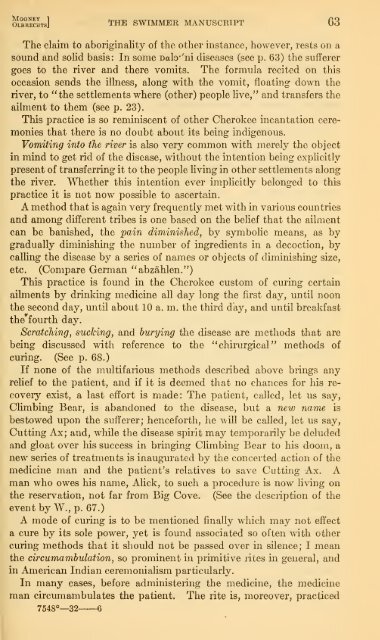Untitled - Smithsonian Institution
Untitled - Smithsonian Institution
Untitled - Smithsonian Institution
Create successful ePaper yourself
Turn your PDF publications into a flip-book with our unique Google optimized e-Paper software.
O^BRECHTs] THE SWIMMER MANUSCRIPT 63<br />
The claim to aboriginality of the other instance, however, rests on a<br />
sound and solid basis: In some Dalo''ni diseases (see p. 63) the sufferer<br />
goes to the river and there vomits. The formula recited on this<br />
occasion sends the illness, along with the vomit, floating down the<br />
river, to "the settlements where (other) people live," and transfers the<br />
ailment to them (see p. 23).<br />
This practice is so reminiscent of other Cherokee incantation ceremonies<br />
that there is no doubt about its being indigenous.<br />
Vomiting into the river is also very common with merely the object<br />
in mind to get rid of the disease, without the intention being explicitly<br />
present of transferring it to the people living in other settlements along<br />
the river. Whether this intention ever implicitly belonged to this<br />
practice it is not now possible to ascertain.<br />
A method that is again very frequently met with in various countries<br />
and among different tribes is one based on the belief that the ailment<br />
can be banished, the pain diminished, by symbolic means, as by<br />
gradually diminishing the number of ingredients in a decoction, by<br />
calling the disease by a series of names or objects of diminishing size,<br />
etc. (Compare German "abzahlen.")<br />
This practice is found in the Cherokee custom of curing certain<br />
ailments by drinking medicine all day long the first day, until noon<br />
the second day, until about 10 a. in. the third day, and until breakfast<br />
the^fourth day.<br />
6<br />
Scratching, sucking, and burying the disease are methods that are<br />
being discussed with reference to the " chirurgical " methods of<br />
curing. (See p. 68.)<br />
If none of the multifarious methods described above brings any<br />
relief to the patient, and if it is deemed that no chances for his re-<br />
covery exist, a last effort is made: The patient, called, let us say.<br />
Climbing Bear, is abandoned to the disease, but a new name is<br />
bestowed upon the sufferer; henceforth, he will be called, let us say.<br />
Cutting Ax; and, while the disease spirit may temporarily be deluded<br />
and gloat over his success in bringing Climbing Bear to his doom, a<br />
new series of treatments is inaugurated by the concerted action of the<br />
medicine man and the patient's relatives to save Cutting Ax. A<br />
man who owes his name, Alick, to sach a procedure is now living on<br />
the reservation, not far from Big Cove. (See the description of the<br />
event by W., p. 67.)<br />
A mode of curing is to be mentioned finally which may not effect<br />
a cure by its sole power, yet is found associated so often with other<br />
curing methods that it should not be passed over in silence; I mean<br />
the circumambulation, so prominent in primitive rites in general, and<br />
in American Indian ceremonialism particularly.<br />
In many cases, before administering the medicine, the medicine<br />
man circumambulates the patient. The rite is, moreover, practiced<br />
7548°—32—

















